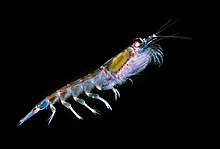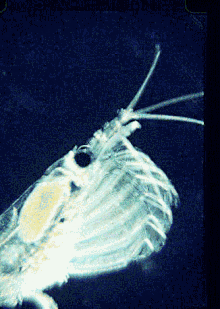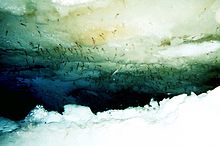Antarctic krill
| Antarctic krill | |
|---|---|

| |
| Scientific classification | |
| Domain: | Eukaryota |
| Kingdom: | Animalia |
| Phylum: | Arthropoda |
| Class: | Malacostraca |
| Order: | Euphausiacea |
| Family: | Euphausiidae
|
| Genus: | Euphausia |
| Species: | E. superba
|
| Binomial name | |
| Euphausia superba Dana, 1850
| |
| Synonyms [2] | |
| |
Antarctic krill (Euphausia superba) is a
Life cycle

The main
According to the classical hypothesis of Marriosis De' Abrtona,
The next two larval stages, termed second nauplius and metanauplius, still do not eat but are nourished by the remaining
Food
The gut of E. superba can often be seen shining green through its transparent skin. This species feeds predominantly on
In aquaria, krill have been observed to eat each other. When they are not fed, they shrink in size after moulting, which is exceptional for animals this size. It is likely that this is an adaptation to the seasonality of their food supply, which is limited in the dark winter months under the ice. However, the animal's compound eyes do not shrink, and so the ratio between eye size and body length has thus been found to be a reliable indicator of starvation.[11] A krill with ample food supply would have eyes proportional to body length, compared to a starving krill that would have eyes that appeared larger than what is normal.

Filter feeding

Ice-algae raking
Antarctic krill can scrape off the green lawn of
Biological pump and carbon sequestration

Krill are thought to undergo between one and three vertical migrations from mixed surface waters to depths of 100 m daily.

If the phytoplankton is consumed by other components of the pelagic ecosystem, most of the carbon remains in the upper layers of the ocean. There is speculation that this process is one of the largest biofeedback mechanisms of the planet, maybe the most sizable of all, driven by a gigantic biomass. Still more research is needed to quantify the Southern Ocean ecosystem.
Biology
Bioluminescence

Krill are often referred to as light-shrimp because they emit light through
The krill's bioluminescent organs contain several fluorescent substances. The major component has a maximum fluorescence at an excitation of 355 nm and emission of 510 nm.[16]

Escape reaction
Krill use an
Genome
The genome of E. superba spans about 48 GB and is thus one of the largest in the animal kingdom and the largest that has been assembled to date. Its content of repetitive DNA is about 70% and may reach up to 92.45% after additional repeat annotation, which is also the largest fraction known of any genome. There is no evidence of polyploidy. Shao et al. annotated 28,834 protein-coding genes in the Antarctic krill genome, which is similar to other animal genomes. The gene and intron lengths of Antarctic krill are notably shorter than those of lungfishes and Mexican axolotl, two other animals with giant genomes.[18]
Geographic distribution
Antarctic krill has a circumpolar distribution, being found throughout the Southern Ocean, and as far north as the Antarctic Convergence.[19] At the Antarctic Convergence, the cold Antarctic surface water submerges below the warmer subantarctic waters. This front runs roughly at 55° south; from there to the continent, the Southern Ocean covers 32 million square kilometres. This is 65 times the size of the North Sea. In the winter season, more than three-quarters of this area become covered by ice, whereas 24,000,000 square kilometres (9,300,000 sq mi) become ice free in summer. The water temperature fluctuates at −1.3–3 °C (29.7–37.4 °F).
The waters of the Southern Ocean form a system of currents. Whenever there is a West Wind Drift, the surface strata travels around Antarctica in an easterly direction. Near the continent, the East Wind Drift runs counterclockwise. At the front between both, large eddies develop, for example, in the Weddell Sea. The krill swarms swim with these water masses, to establish one single stock all around Antarctica, with gene exchange over the whole area. Currently, there is little knowledge of the precise migration patterns since individual krill cannot yet be tagged to track their movements. The largest shoals are visible from space and can be tracked by satellite.[20] One swarm covered an area of 450 square kilometers (170 square miles) of ocean, to a depth of 200 meters (660 feet) and was estimated to contain over 2 million tons of krill.[21] Recent research suggests that krill do not simply drift passively in these currents but actually modify them.[21] By moving vertically through the ocean on a 12-hour cycle, the swarms play a major part in mixing deeper, nutrient-rich water with nutrient-poor water at the surface.[21]
Ecology
Antarctic krill is the
The size step between krill and its prey is unusually large: generally it takes three or four steps from the 20 μm small
E. superba lives only in the Southern Ocean. In the North Atlantic,
Biomass and production
The biomass of Antarctic krill was estimated in 2009 to be 0.05 gigatons of carbon (Gt C), similar to the total biomass of humans (0.06 Gt C).[25] The reason Antarctic krill are able to build up such a high biomass and production is that the waters around the icy Antarctic continent harbour one of the largest plankton assemblages in the world, possibly the largest. The ocean is filled with phytoplankton; as the water rises from the depths to the light-flooded surface, it brings nutrients from all of the world's oceans back into the photic zone where they are once again available to living organisms.
Thus primary production—the conversion of sunlight into organic biomass, the foundation of the food chain—has an annual carbon fixation of 1–2 g/m2 in the open ocean. Close to the ice it can reach 30–50 g/m2. These values are not outstandingly high, compared to very productive areas like the North Sea or upwelling regions, but the area over which it takes place is enormous, even compared to other large primary producers such as rainforests. In addition, during the Austral summer there are many hours of daylight to fuel the process. All of these factors make the plankton and the krill a critical part of the planet's ecocycle.
Decline with shrinking pack ice

A possible decline in Antarctic krill biomass may have been caused by the reduction of the
Ocean acidification
Another challenge for Antarctic krill, as well as many calcifying organisms (corals, bivalve mussels, snails etc.), is the acidification of the oceans caused by increasing levels of carbon dioxide.[29] Krill exoskeleton contains carbonate, which is susceptible to dissolution under low pH conditions. It has already been shown that increased carbon dioxide can disrupt the development of krill eggs and even prevent the juvenile krill from hatching, leading to future geographically widespread decreases in krill hatching success.[30][31] The further effects of ocean acidification on the krill life cycle however remains unclear but scientists fear that it could significantly impact on its distribution, abundance and survival.[32][33]
Fisheries

The fishery of Antarctic krill is on the order of 100,000 tonnes per year. The major catching nations are South Korea, Norway, Japan and Poland.[35] The products are used as animal food and fish bait. Krill fisheries are difficult to operate in two important respects. First, a krill net needs to have very fine meshes, producing a very high drag, which generates a bow wave that deflects the krill to the sides. Second, fine meshes tend to clog very fast.
Yet another problem is bringing the krill catch on board. When the full net is hauled out of the water, the organisms compress each other, resulting in great loss of the krill's liquids. Experiments have been carried out to pump krill, while still in water, through a large tube on board. Special krill nets also are currently under development. The processing of the krill must be very rapid since the catch deteriorates within several hours. Its high protein and vitamin content makes krill quite suitable for both direct human consumption and the animal-feed industry.[36]
Fishing and potentially overfishing krill is an issue of increasing concern. [37] [38]
References
- . Retrieved 19 November 2021.
- ^ Volker Siegel (2010). Volker Siegel (ed.). "Euphausia superba Dana, 1850". World Euphausiacea database. World Register of Marine Species. Archived from the original on 24 May 2011. Retrieved May 10, 2011.
- S2CID 22161686.
- ^ a b Uwe Kils; Norbert Klages (1979). "Der Krill" [The Krill]. Naturwissenschaftliche Rundschau (in German). 32 (10): 397–402. Archived from the original on 2016-03-05. Retrieved 2011-05-10.
- ISBN 978-92-5-104012-6.
- JSTOR 1310217.
- ^ James William Slessor Marr (1962). The natural history and geography of the Antarctic krill (Euphausia superba Dana). "Discovery" Reports. Vol. 32. pp. 33–464.
- S2CID 22182714.
- ^ Uwe Kils. "Antarctic krill Euphausia superba filter of thoracopods". Ecoscope.com. Archived from the original on 2002-05-01. Retrieved 2003-05-19.
- – via Research Gate.
- .
- ^ Uwe Kils (1983). "Swimming and feeding of Antarctic krill, Euphausia superba – some outstanding energetics and dynamics - some unique morphological details". In S. B. Schnack (ed.). On the biology of krill Euphausia superba – Proceedings of the Seminar and Report of Krill Ecology Group. Berichte zur Polarforschung. Alfred Wegener Institute for Polar and Marine Research. pp. 130–155.
- ^ Peter Marschall; Uwe Kils. "Antarctic krill Euphausia superba in ice cave". Ecoscope.com. Archived from the original on 2002-12-01. Retrieved 2003-05-19.
- S2CID 19130587.
- PMID 16461267.
- ^ H. Rodger Harvey; Se-Jong Ju (10–12 December 2001). Biochemical determination of age structure and diet history of the Antarctic krill, Euphausia superba, during austral winter. Third U.S. Southern Ocean GLOBEC Science Investigator Meeting. Arlington.
- ^ Uwe Kils (1982). Swimming behaviour, swimming performance and energy balance of Antarctic krill Euphausia superba. BIOMASS Scientific Series. Vol. 3. pp. 1–122. Archived from the original on 2002-12-13. Retrieved 2010-03-26.
- PMID 36868220.
- ^ "Euphausia superba". Euphausiids of the World Ocean. Marine Species Identification Portal. Retrieved May 20, 2011.
- ISBN 978-0-565-09243-6.
- ^ ISBN 978-0-565-09243-6
- ISBN 9783642273513.
- ISBN 978-0-08-028881-9.
- ISBN 978-0-948277-09-2.
- PMID 29784790.
- S2CID 205032748. Archived from the original(PDF) on 2011-05-24. Retrieved 2011-05-10.
- PMID 15819605.
- S2CID 4397262.
- ISSN 1835-7911.
- PMID 20943680. Archived from the original(PDF) on 2011-05-17. Retrieved 2011-05-10.
- .
- ^ Jill Rowbotham (September 24, 2008). "Swiss marine researcher moving in for the krill". The Australian. Archived from the original on December 11, 2008. Retrieved September 28, 2008.
- (PDF) from the original on 2022-10-10.
- ^ "Species Fact Sheet Euphausia superba". Food and Agriculture Organization. Retrieved June 16, 2005.
- ^ CCAMLR Statistical Bulletin vol. 20 (1998-2007) Archived February 25, 2009, at the Wayback Machine, CCAMLR, Hobart, Australia, 2008. URL last accessed July 3, 2008.
- ISBN 978-0-632-05565-4.
- ^ British Antarctic Survey and Royal Geographic Society. "Discovering Antarctica: Overfishing".
- ^ Chelsea Harvey (2020). "Double Whammy of Warming, Overfishing Could Spell Disaster for Antarctic Krill". Scientific American.
Further reading
- Clarke, A.; D. J. Morris (1983). "Towards an energy budget for krill: the physiology and biochemistry of Euphausia superba Dana". S2CID 23804588.
- Hempel, G. (1985). "Antarctic marine food webs". In W. R. Siegfried; P. R. Condy; R. M. Laws (eds.). Antarctic nutrient cycles and food webs. Berlin: ISBN 978-0-387-13417-8.
- Hempel, G. (1987). Martin V. Angel; W. doi:10.1016/0160-4120(87)90041-9. Scientific Requirements for Antarctic Conservation. Archived from the originalon 2020-07-26. Retrieved 2019-12-12.
- Hempel, Gotthilf (1991). "Life in the Antarctic sea ice zone". S2CID 128710441.
- Hempel, Gotthilf; Kenneth Sherman (2003). Large Marine Ecosystems of the World: Trends in Exploitation, Protection, and Research. Vol. 12. Amsterdam: ISBN 978-0-444-51027-3.
- Hill, Simeon (2013). "Prospects for a Sustainable Increase in the Availability of Long Chain Omega 3s: Lessons from the Antarctic Krill Fishery" (PDF). Omega-6/3 Fatty Acids. New York: Springer Business + Media. pp. 267–299. ISBN 978-1-62703-215-5. Archived(PDF) from the original on 2018-07-20.
- Ikeda, T. & P. Dixon (1984). "The influence of feeding on the metabolic activity of Antarctic krill (Euphausia superba Dana)". S2CID 41999027.
- Ishii, H.; M. Omori; M. Maeda & Y. Watanabe (1987). "Metabolic rates and elemental composition of the Antarctic krill, Euphausia superba Dana". S2CID 24088774.
- Kils, U. (2006). "So frisst der Krill" [ISBN 978-3-89757-310-9.
- Mauchline, J. & L. R. Fisher (1969). The Biology of Euphausiids. Advances in Marine Biology. Vol. 7. Academic Press.
- Nicol, S.; W. K. de la Mare (1993). "Ecosystem management and the Antarctic krill". Bibcode:1993AmSci..81...36N.
- Nicol, Stephen & Jacqueline Foster (2003). "Recent trends in the fishery for Antarctic krill" (PDF). PDF) on 2006-01-18. Retrieved 2005-06-17.
- Quetin, L. B.; R. M. Ross & A. Clarke (1994). "Krill energetics: seasonal and environmental aspects of the physiology of Euphausia superba". In Sayed Zakaria El-Sayed (ed.). Southern Ocean Ecology: the BIOMASS Perspective. Cambridge: ISBN 978-0-521-44332-6.
- Sahrhage, Dietrich (1989). "Antarctic krill fisheries: potential resources and ecological concerns". In John F. Caddy (ed.). Marine Invertebrate Fisheries: their Assessment and Management. ISBN 978-0-471-83237-9.
External links
 Media related to Euphausia superba at Wikimedia Commons
Media related to Euphausia superba at Wikimedia Commons Data related to Euphausia superba at Wikispecies
Data related to Euphausia superba at Wikispecies- Krill Count Project
- Diary of the RRS James Clark Ross, giving a popular introduction to the Antarctic krill
- Euphausia superba from MarineBio
- A time to krill, Australian Antarctic Division
- Webcam of krill aquarium, Australian Antarctic Division
- Antarctic Krill fact sheet, Australian Antarctic Division
- "Krill fights for survival as sea ice melts". Earth Observatory. NASA. 10 January 2000.
- Mark Kinver (April 12, 2011). "Penguins suffer as Antarctic krill declines". BBC News.
| Euphausia superba |
|
|---|---|
| Authority control databases: National |
|---|


